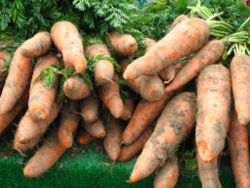Carrot
"Carrot" is the common name for a root vegetable whose scientific name is Daucus carota. Figuratively, a "carrot" is a reward, contrasted to the notion of punishment in the expression "carrot and stick."
It is a popular misconception that all carrots are orange. It is true that most commercially grown carrots demanded by today's supermarkets and green grocers are orange; however, the first traditional varieties of carrot where white, purple, red, yellow, green and black in colour. It was Dutch growers who first cultivated the orange colour by combining red and yellow varieties. All modern orange varieties are descended from these Dutch cultivars.
Nutrition
Carrots have a woody texture and can be eaten raw, cooked or juiced and contain large amounts of Beta-Carotine which our bodies convert into Vitamin A. One carrot can contain up to 240% of the RDA of Vitamin A which has earned it a reputation for helping you see in the dark. However while a deficiency of Vitamin A can reduce the eye's performance in reduced light, Vitamin A can only correct this deficiency. It cannot improve your ability to see in the dark beyond what is normal for the human eye.
Carrots also contain high values of dietary fiber, Vitamin A, Vitamin C, Vitamin K, Potassium, Thiamin, Niacin, Vitamin B6, Folate and Manganese.
One medium sized carrot contains about 40 calories.
Varieties
- Early Nantes: A quick developing variety ideal for early cropping.
- Autumn King: A slower developing variety with a larger root.
Sowing
Carrots can be sown under cover from as early as January or outdoors after the last frosts in March or April. Carrots are best sown directly into the ground (or their adult containers). The seeds are extremely small, and many gardeners find it helpful to use a syringe-like tool to dispense them. Another convenience for small gardens is to use a commercial, biodegradable paper strip into which seeds have been inserted mechanically, at regular intervals. Strips, however, are only available for a few cultivars.
Transplanting carrots invariably results in twisted roots and branched roots that are not only difficult to cook with but are often stunted and can even split.
As the young carrots continue to grow they should be thinned regularly leaving a distance of 5 to 7cm between each plant. The small thinned carrots are suitable for use in salads and needn't be discarded.
Pests
The most common pest known the affect carrots is the carrot fly. The small grubs of the carrot fly eat and tunnel their way through the carrot making it inedible and stunting its growth.
Slugs and snails generally leave carrots alone although on occasion they will eat around the stems at the top of any roots protruding from the ground.
It is common in American folklore to assume rabbits are incredibly fond of carrots, especially the cartoon character, Bugs Bunny. Rabbits, in fact, like most fresh vegetables.
Homonyms
- Carat: unit for measuring the weight of precious stones; also (UK English), unit for measuring the proportion of gold in an alloy, such that 24 carats is pure gold
- Caret: (UK English) the punctuation mark (^), sometimes called a "top hat"
- Karat: (American English) unit for measuring the proportion of gold in a piece of metal (usually jewelry)
